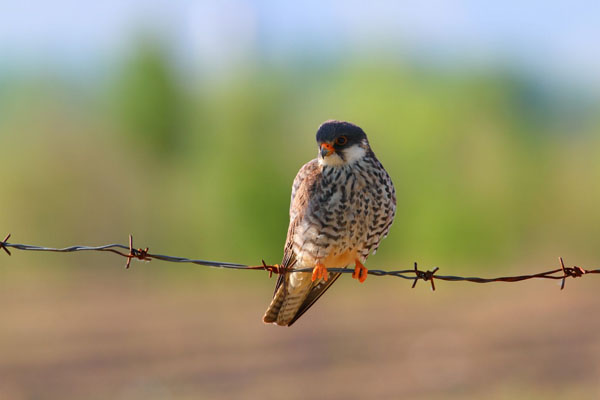Falco amurensis
IUCN
LCBasic Information
Scientific classification
- name:Falco amurensis
- Scientific Name:Red-footed falcon, Amur falcon, blue eagle, blue swallow, black kite, red-legged kite, grasshopper hawk
- Outline:Raptor
- Family:Falconiformes Falconidae Falco
Vital signs
- length:26-30cm
- Weight:124-190g
- lifetime:12~16year
Feature
The raptor has the longest migration distance, with a one-way distance of 13,000 to 16,000 kilometers.
Distribution and Habitat
It is found in most provinces in Northeast China, North China, East China, Central China, Southeast China, South China and Southwest China. It breeds in Northeast Asia, migrates through East Asia, South Asia and Southeast Asia, and hibernates in Africa. It mainly inhabits open areas such as sparse forests in low mountains, forest edges, plains at the foot of mountains, swamps, grasslands, rivers, valleys and farmland in hilly areas, especially plains, low mountains and hilly areas with sparse trees.
Appearance
Small raptor, smaller than the falcon. No obvious wing fingers. Body and immature bird feathers are similar to those of the falcon, but the claws (nails) are yellow, not black like the falcon. Adults have orange-red eye circles, orange-red beaks with only the tip darker, orange-red wax at the base of the beak, orange-red legs and feet, and red belly and undertail coverts. The male has a dark smoky gray head and upper body, light gray underbody, similar to the male Western Red-footed Falcon, but when flying, its pure white underwing coverts can be seen in sharp contrast to the pure black flight feathers. The female has scaly horizontal stripes on the upper body, white cheeks, with dark gray lighter sideburns, black vertical stripes on the upper chest, white from the lower chest to the abdomen, with black spear-shaped horizontal stripes, and white underwing coverts with black spots. Immature birds are similar to females, but the red is lighter and less obvious, and there are messy and de
Details
Red-footed falcons often inhabit open habitats and like to stand on electric wires. They also form large groups of dozens of individuals to prey on insects in one area at the same time. Sometimes they also mix with other falcons, such as yellow-clawed falcons. They often move alone during the day. When flying, they flap their wings quickly, occasionally glide, and can also make a short stop in the air by flapping their wings quickly. They mainly feed on locusts, grasshoppers, mole crickets, crickets, beetles, crickets, click beetles and other insects. Sometimes they also prey on small birds, lizards, skinks, frogs, mice and other small vertebrates. Pests account for more than 90% of their food, and they have made outstanding achievements in eliminating pests.

Red-footed falcons breed from May to July every year. They often occupy the nests of magpies. In the ancient Chinese Book of Songs, there is a poem that says "The magpie has a nest, and the dove lives in it". The "dove" in this phenomenon of "the magpie's nest is occupied by the dove" refers to the red-footed falcon. Sometimes they also build their own nests, usually on the top branches of tall trees in sparse forests. The nest is approximately spherical, with a top cover and two exits on the side. Some nests are not spherical. It is mainly composed of dry branches of trees such as larch, oak, and locust. In China, the spring migration to the northern breeding grounds is mostly in late April to early May, and the autumn migration to the breeding grounds is mostly in late October to early November.
In the migration season, the red-footed falcon travels from Northeast Asia to the southwest through India, and finally flies to southeast Africa for wintering. It returns to Russia and other places again in the spring of the following year. The round trip can be as long as more than 30,000 kilometers. In the past, it was regarded as a subspecies of the western red-footed falcon, but now most classifications believe that it is an independent species. In October 2012, the "Protect India" organization accidentally discovered the collective slaughter of Amur falcons by local people in the mountains of Kalam, India. It is estimated that as many as 120,000 to 140,000 Amur falcons passing through the area die at the hands of hunters each year. This may be just the tip of the iceberg of human threats to this species in its long global migration route.
The first need of life is survival. Every species has the right to protect its own survival. For each of us, we should start with ourselves. Respecting life is respecting humanity itself.








